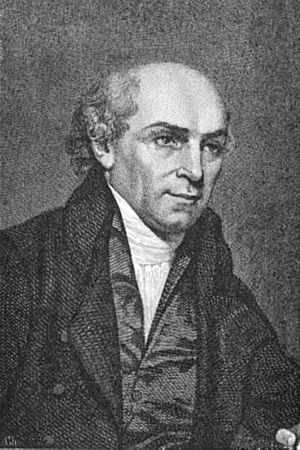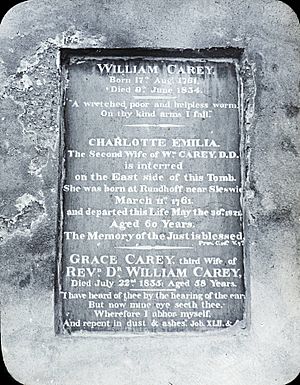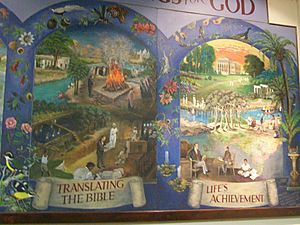William Carey (missionary) facts for kids
Quick facts for kids
William Carey
|
|
|---|---|

Portrait of Carey, c. 1887
|
|
| Born | 17 August 1761 Paulerspury, England
|
| Died | 9 June 1834 (aged 72) |
| Signature | |
 |
|
William Carey (born August 17, 1761 – died June 9, 1834) was an English Christian missionary. He was also a Particular Baptist minister, a translator, and a social reformer. He is famous for starting Serampore College and Serampore University in India. This was the first university in India that could give out degrees.
Carey traveled to Calcutta (Kolkata) in 1793. He later moved to the Danish colony of Frederiksnagar in Serampore. One of his first big projects was opening schools for poor children. They learned reading, writing, math, and about Christianity. He also started the first university for religious studies in Serampore. He worked hard to stop the practice of sati, a harmful tradition.
People call Carey the "father of modern missions." His important essay, An Enquiry into the Obligations of Christians to Use Means for the Conversion of the Heathens, helped create the Baptist Missionary Society. The The Asiatic Society praised Carey for sharing Indian literature with Europe. They also noted his knowledge of India's science, nature, and plants.
He translated the Hindu story, the Ramayana, into English. He also translated the Bible into many Indian languages. These included Bengali, Punjabi, Oriya, Assamese, Marathi, Hindi, and Sanskrit. William Carey is remembered as a great reformer and Christian missionary.
Contents
Early Life and Learning
William Carey was the oldest of five children. He was born to Edmund and Elizabeth Carey, who were weavers. This was in a small village called Pury End in Northamptonshire, England. William grew up in the Church of England. When he was six, his father became the village schoolmaster.
As a child, William was very curious. He loved natural sciences, especially botany (the study of plants). He was also naturally good at languages. He taught himself Latin on his own.
At 14, Carey started working for a cordwainer (shoemaker) named Clarke Nichols. This was in a nearby village. Through another apprentice, John Warr, Carey joined a small church group called Dissenters. While learning shoemaking, he also taught himself Greek. A local weaver helped him with this.
When Nichols died, Carey took over the shoemaking business. He married Dorothy Plackett in 1781. Dorothy could not read or write. William and Dorothy had seven children, but two daughters and one son died young. While working, Carey continued to learn languages. He taught himself Hebrew, Italian, Dutch, and French.
Carey always remembered his humble beginnings. He often called himself a "cobbler." One book about him is even titled William Carey the Shoemaker Who Became the Father and Founder of Modern Missions.
Starting the Baptist Missionary Society
Carey joined a group of Particular Baptists. He met friends like John Ryland and Andrew Fuller. They asked him to preach in their church. In 1783, William Carey was baptised and became a Baptist.
In 1785, Carey became a schoolmaster in Moulton. He also served as a pastor for a local Baptist church. During this time, he read about missionaries and explorers like James Cook. He became very interested in sharing the Christian Gospel around the world.
In 1789, Carey became a full-time pastor in Leicester. Three years later, in 1792, he wrote an important book. It was called An Enquiry into the Obligations of Christians to use Means for the Conversion of the Heathens. This book argued that Christians should spread their faith.
The book had five parts. It said that Jesus' command to make disciples (followers) was still important. It also shared the history of missionary work. Carey included 26 pages of tables with facts about countries and religions. He had collected this information as a teacher. The book also answered common questions about sending missionaries. Finally, it asked Baptists to form a missionary society.
Carey convinced others to support missionary work. The Baptist Missionary Society was started in October 1792. Carey, Andrew Fuller, and others were founding members. They raised money and decided where to send missionaries. They chose India and decided Carey would go with Dr. John Thomas, a medical missionary.
Life as a Missionary in India

Carey, his oldest son Felix, and Dr. Thomas sailed from London in April 1793. Carey's wife, Dorothy, first refused to go. She was pregnant and had never left home. But she later agreed to join them with her sister. Their journey was delayed because the British East India Company did not want missionaries in India. They finally found a Danish ship and landed in Calcutta in November.
For their first year, the missionaries looked for ways to support themselves. They also started learning the Bengali language. A friend of Dr. Thomas offered Carey a job managing an indigo factory. So, Carey moved his family to Midnapore. For six years, he managed the factory. During this time, he worked on his Bengali New Testament translation. He also thought about how his mission community would work. He believed in living together, being financially independent, and training local ministers. Sadly, his son Peter died from a sickness. This stress caused Dorothy to become very ill, and she never fully recovered.
More missionaries arrived from the society. They included William Ward, a printer, and Joshua Marshman, a schoolteacher. Because the East India Company was still unfriendly to missionaries, they settled in the Danish colony of Serampore. Carey joined them there on January 10, 1800.
Working in Serampore
Once in Serampore, the mission bought a large house. It was big enough for all their families and a school. This school helped them earn money. Ward set up a printing press. He started printing the Bible in Bengali. In August 1800, another missionary died. By the end of that year, the mission had its first local convert, a Hindu named Krishna Pal. They also gained the support of the local Danish government.
A new question came up when Hindus became Christians. Should converts keep their caste? In 1802, Krishna Pal's daughter married a man from a different caste. This wedding showed that the church did not believe in caste differences.
In 1801, two more missionaries died. That same year, the Governor-General started Fort William College. This college was for training government workers. He offered Carey a job as a professor of Bengali. Carey worked with Indian scholars there. One scholar taught him Sanskrit. Carey wrote grammar books for Bengali and Sanskrit. He also started translating the Bible into Sanskrit. He used his influence to help stop harmful practices like infant sacrifice and suttee. He found that these practices were not based on Hindu sacred writings.
Dorothy Carey died in 1807. Her long illness had been a challenge for the mission. William continued his studies and translations. Friends had suggested sending Dorothy to an asylum. But William chose to keep her at home, caring for her himself.
In 1808, Carey married Charlotte Rhumohr. She was a Danish member of his church and was very intelligent. They were married for 13 years until she died.
The mission's printing press produced many Bible translations. They printed Bibles in Bengali, Sanskrit, and other languages. Many of these languages had never been printed before. William Ward even had to create the metal type pieces by hand. Carey also translated Indian literature into English.
On March 11, 1812, a fire destroyed the print shop. They lost many important papers, including some of Carey's translations. But the press and type pieces were saved. The mission was able to start printing again in six months. During Carey's life, the mission printed parts or all of the Bible in 44 languages.
In 1818, the mission started Serampore College. It was to train local ministers and offer education in arts and sciences. People of any caste or country could attend. In 1827, the King of Denmark gave the college a special permission. This made it the first degree-granting college in Asia.
In 1820, Carey started the Agri Horticultural Society of India. This showed his love for botany. A plant genus, Careya, was named after him.
Carey's second wife, Charlotte, died in 1821. His oldest son, Felix, also died. In 1823, he married for a third time to Grace Hughes.
Over time, there were some disagreements within the Missionary Society. New missionaries arrived who did not want to live communally. They sometimes found the work too hard. Andrew Fuller, a key leader in England, had died. His replacement tried to manage the mission from England. These differences became too big. Carey eventually left the society he had founded. He moved to the college grounds. He lived a quiet life until he died in 1834. He continued to revise his Bengali Bible, preach, and teach students.
Translations, Education, and Schools
Carey spent a lot of time studying Indian languages. He learned Bengali and many other local languages. He also studied Sanskrit, an ancient root language. With the College of Fort William, Carey translated Hindu classics into English. He started with the epic poem, the Ramayana.
He then translated the Bible into Bengali, Oriya, Marathi, Hindi, Assamese, and Sanskrit. He also translated parts of it into other languages. For 30 years, Carey was a professor at the college. He taught Bengali, Sanskrit, and Marathi. In 1805, he published the first book on Marathi grammar.
The Serampore Mission Press that Carey started was very important. It was known for making special typefaces for Indian languages. Carey and his team created textbooks, dictionaries, and classic literature. These books helped children, college students, and the general public. They also made the first complete Sanskrit grammar book.
In the late 1700s and early 1800s in India, only some children went to school. Education was mostly for boys from certain social groups. Girls were not usually schooled at all. Carey started Sunday Schools where children learned to read using the Bible. In 1794, Carey opened what is thought to be the first primary school in all of India. The public school system he began also included girls. This was a new idea at the time. Carey's work helped start the Christian Vernacular Education Society. This group provided English education across India.
Legacy and Impact
William Carey lived in India for 41 years without returning home. His mission had about 700 converts. But he built a strong foundation for Bible translations, education, and social reform. He is called the "father of modern missions." He is also known as "India's first cultural anthropologist."
His teaching, translations, writings, and schools had a huge impact. They are said to have changed Indian culture for the better.
Carey was very important in starting Serampore College in Serampore.
Carey's strong belief in change led to the creation of the Baptist Missionary Society.
Many schools are named after him. These include William Carey Christian School in Sydney, Australia, and William Carey International University in California. There are also Carey Theological College in Canada, Carey Baptist College in New Zealand, and William Carey University in Mississippi. In Bangladesh, there is the William Carey Academy and William Carey International School. The William Carey Memorial School is in Serampore, India.
Artefacts and Museums
St James Church in Paulerspury, England, has a display about William Carey. He was christened there and attended as a boy. Carey Baptist Church in Moulton, England, also has items related to him. His nearby cottage is also a historical site.
In Leicester, England, Harvey Lane Baptist Church, where Carey last served, was destroyed by fire. Carey's cottage there was a museum until it was removed for a new road. Items from that museum are now at the Central Baptist Church in Leicester. This church houses the William Carey Museum.
The Angus Library and Archive in Oxford has the largest collection of Carey's letters. They also have items like his Bible and the sign from his shoemaker shop. The Center for Study of the Life and Work of William Carey at William Carey University in Mississippi also has many historical items.
Images for kids
See also
 In Spanish: William Carey para niños
In Spanish: William Carey para niños
- Carey Baptist Church in Reading, England
- Carey Saheber Munshi
- William Carey University, Meghalaya








